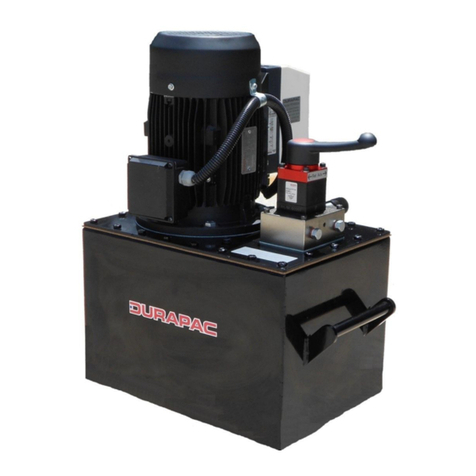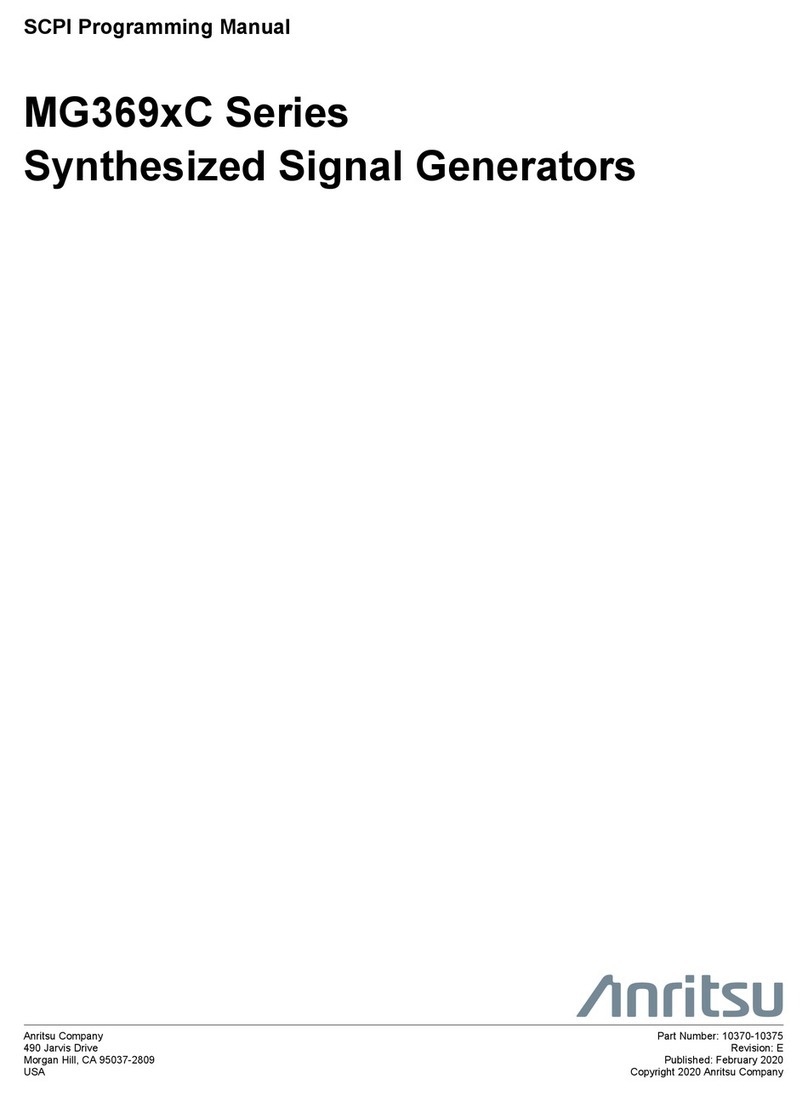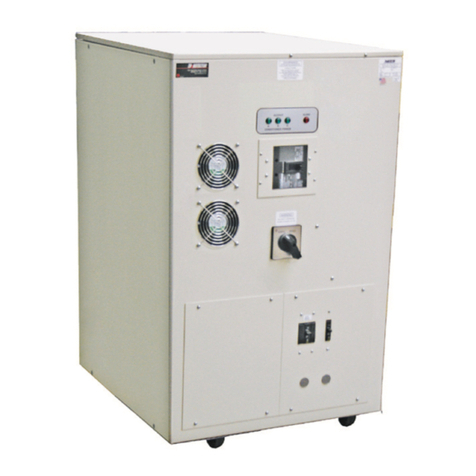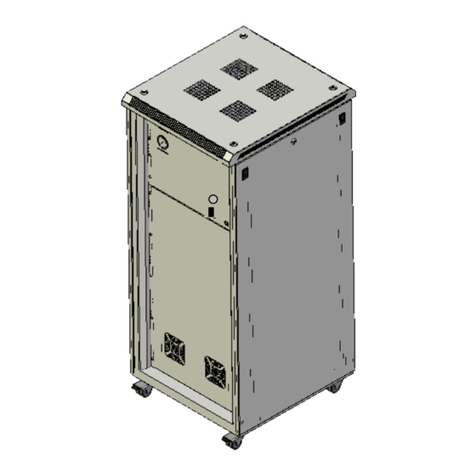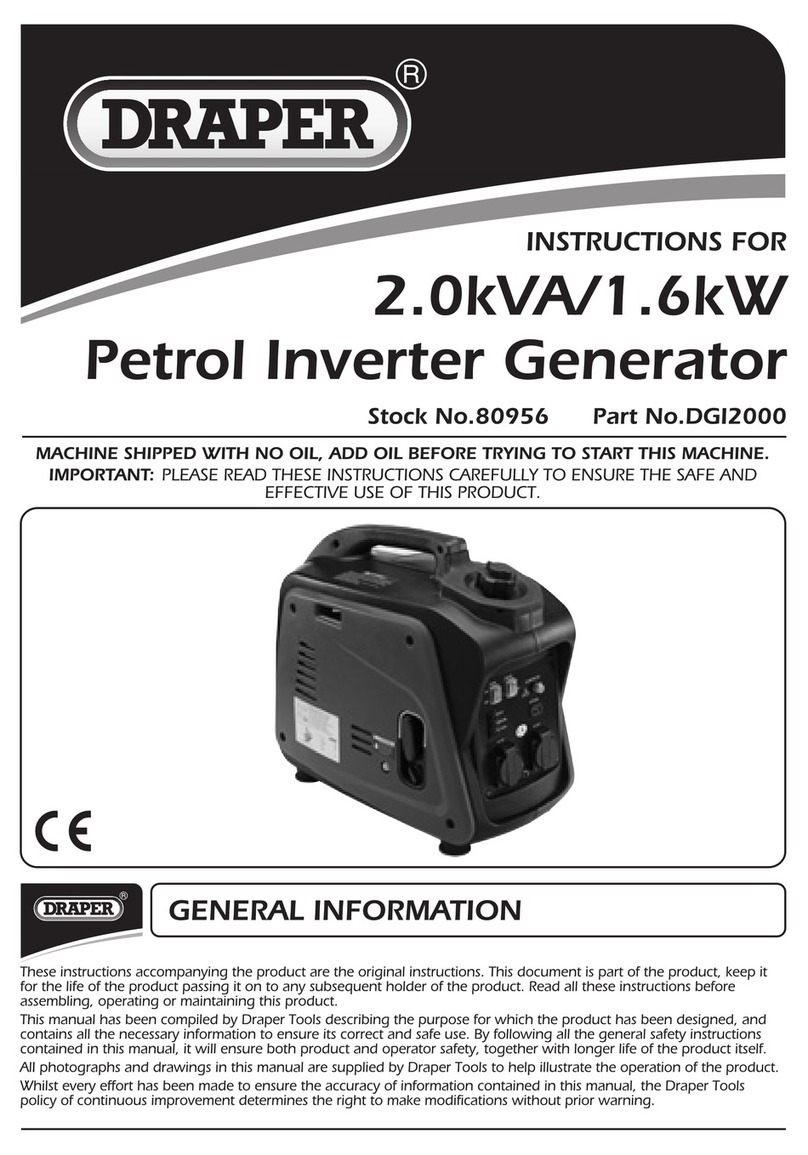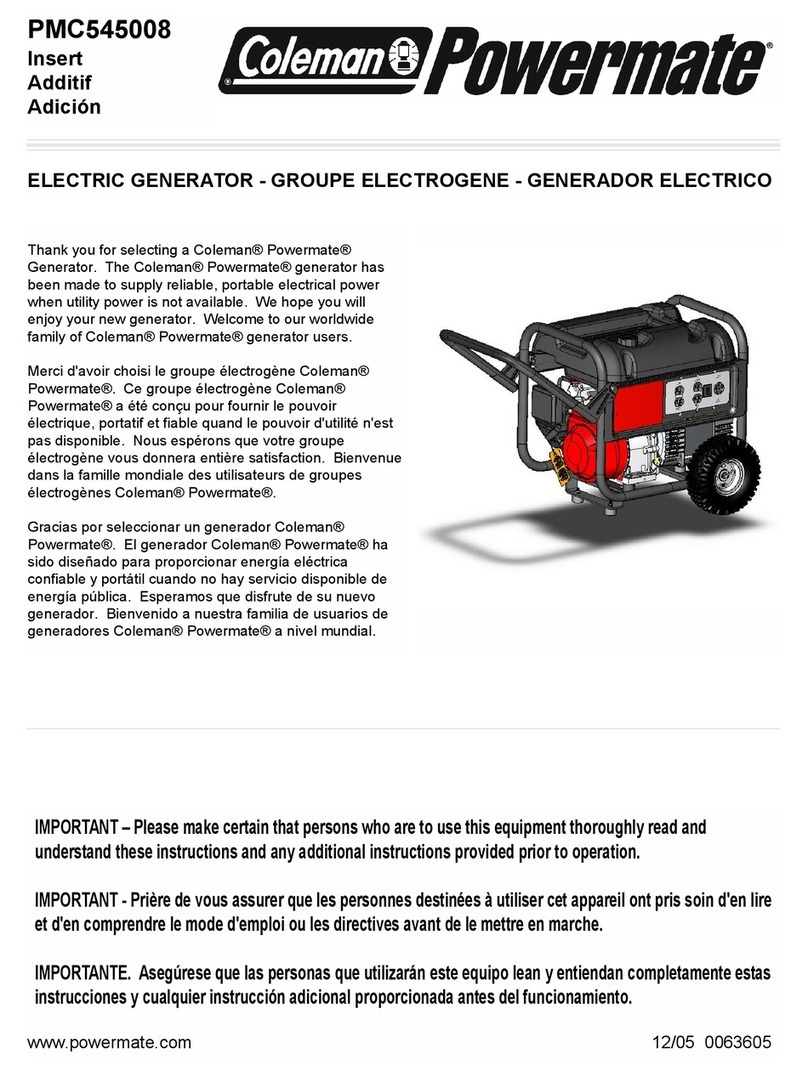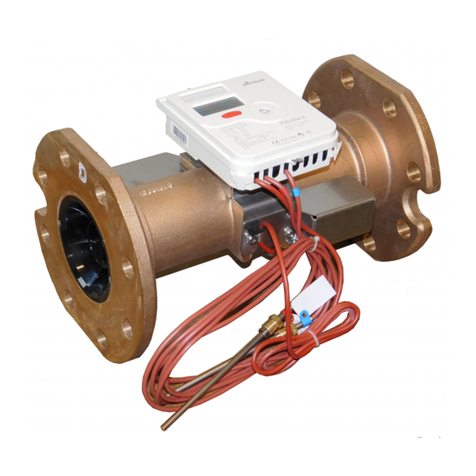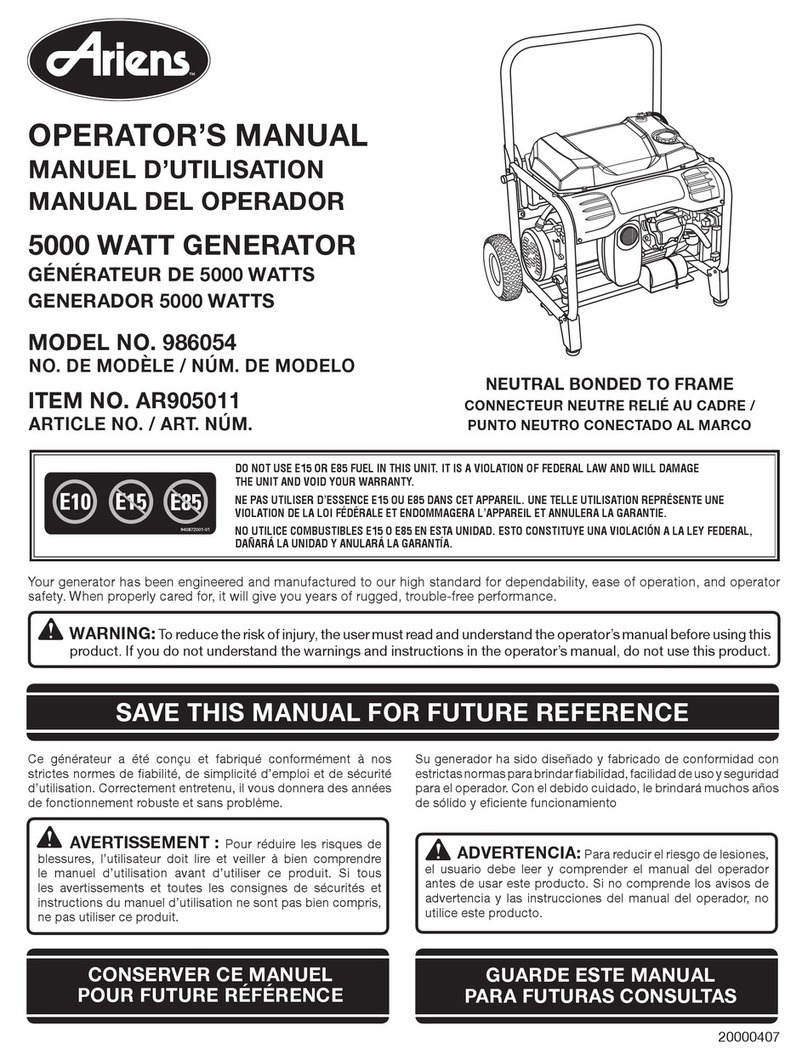Gentherm 5220 User manual

WARNING:
If the information in this
manual is not followed exactly, a fire or
explosion may result causing property
damage, personal injury or loss of life.
Do not store or use gasoline or other
flammable vapors and liquids near this or
any other appliance.
WHAT TO DO IF YOU SMELL GAS:
• Do not try to light any appliance.
• Do not touch any electrical switch; do not
use any phone in your building.
• Immediately call your gas supplier from a
neighbour’s phone. Follow the gas
supplier’s instructions.
• If you cannot reach your gas supplier, call
the fire department.
Installation and service must be performed
by a qualified installer, service agency or the
gas supplier.
WARNING: Improper installation,
adjustment, alteration, service or maintenance
can cause injury or property damage. Read the
installation, operating and maintenance
instructions thoroughly before installing or
servicing this equipment.
WARNING: For Outdoor Use Only.

AVERTISSEMENT:
Si l’information de ce
manuel n’est pas suivie exactement, un
incendie ou une
explosion peut résulter
entraînant des dégâts matériaux, des
blessures ou la perte de vie.
Ne pas entreposer ou utiliser de l’essence,
d’autres liquides ou vapeurs inflammables à
proximité de cet appareil ou d’aucun autre
appareil.
QUE FAIRE SI VOUS SENTEZ LE GAZ:
• N’allumez aucun appareil.
•
Ne touchez aucun commutateur
électrique; n’utilisez pas le téléphone de
votre bâtiment.
• Appelez immédiatement votre fournisseur
de gaz d’un téléphone dans un bâtiment
voisin, si possible. Suivez les instructions
du fournisseur de gaz.
• Si vous ne pouvez pas atteindre votre
fournisseur de gaz, appelez le service
d’incendie.
L'installation et le service doivent être
effectués par un installateur qualifié, une
agence de service ou le fournisseur de gaz.
AVERTISSEMENT: L’installation inexacte,
l’ajustement, le changement, le service ou
l’entretien peuvent causer des dommages ou
des dégâts matériaux. Lisez les instructions
d’installation, d’opération et d’entretien
complètement avant d’installer ou entretenir
cet équipement.
AVERTISSEMENT: Pour l’Usage Extérieur
Seulement.

28142 Rev 15
5220 THERMOELECTRIC GENERATOR
Operating Manual
#16, 7875 - 57th Street SE
Calgary, Alberta Canada T2C 5K7
Main: +1 403 236 5556
Fax: +1 403 236 5575
www.genthermglobalpower.com
NOTICE TO INSTALLER:
These instructions shall be left with the consumer to retain them for future reference.

Gentherm Global Power Technologies I
TABLE OF CONTENTS
1ABOUT THIS MANUAL......................................................................................... 1
1.1 HEALTH AND SAFETY..................................................................................... 1
1.2 TECHNICAL TERMS........................................................................................ 1
2QUICK START PROCEDURE ................................................................................. 3
2.1 INSTALLATION ............................................................................................. 3
2.2 START UP .................................................................................................... 4
2.3 TUNING ....................................................................................................... 4
2.4 PERFORMANCE LOG ...................................................................................... 5
3TECHNICAL SPECIFICATIONS.............................................................................. 6
3.1 OVERVIEW ................................................................................................... 6
3.2 OPTIONS ..................................................................................................... 6
3.3 WEIGHTS AND DIMENSIONS......................................................................... 8
3.4 IGNITION CONTROL SYSTEM.......................................................................... 9
3.5 DATA PLATE ................................................................................................. 9
3.6 FUEL CONSUMPTION ....................................................................................10
3.7 STANDARD SPECIFICATION FOR GASEOUS FUEL.............................................10
4PROCESS DESCRIPTION ....................................................................................12
4.1 MODEL 5220 THERMOELECTRIC GENERATOR ..................................................12
4.2 220-WATT LIMITER......................................................................................17
4.3 220-WATT LIMITER/CONVERTER (L/C) ...........................................................19
4.4 OPTIONAL CATHODIC PROTECTION INTERFACE SYSTEM ..................................20
5INSTALLATION .................................................................................................22
5.1 PRECAUTIONS .............................................................................................22
5.2 TOOLS REQUIRED ........................................................................................22
5.3 UNPACKING ................................................................................................22
5.4 ASSEMBLING...............................................................................................23
5.5 MOUNTING..................................................................................................24
5.6 SUPPLYING FUEL .........................................................................................25
5.7 CONNECTING CUSTOMER LOAD.....................................................................27
5.8 INSTALLATION OF LIMITER/CONVERTER (L/C) ................................................29
5.9 INSTALLATION OF OPTIONAL CP INTERFACE SYSTEM ......................................30
5.10 INSTALLATION OF WIND SCOOP....................................................................32
6STARTUP AND SHUTDOWN ................................................................................34
6.1 BEFORE STARTING.......................................................................................34

Gentherm Global Power Technologies II
6.2 TEG START-UP.............................................................................................34
6.3 SHUTDOWN ................................................................................................34
7POWER OUTPUT EVALUATION ............................................................................35
7.1 AMBIENT TEMPERATURE EFFECTS ON Vset AND RATED POWER ..........................35
7.2 DETERMINING Vset AND RATED POWER GRAPHICALLY ......................................37
7.3 Vset AND RATED POWER ................................................................................37
8ADJUSTMENT ...................................................................................................40
8.1 TUNING THE TEG .........................................................................................40
8.2 ADJUSTMENT OF L/C ASSEMBLY ....................................................................48
8.3 ADJUSTMENT OF LIMITER ASSEMBLY .............................................................50
8.4 ADJUSTMENT OF OPTIONAL CP INTERFACE SYSTEM ........................................51
9MAINTENANCE .................................................................................................53
9.1 RECOMMENDED PERIODIC MAINTENANCE ......................................................53
9.2 FUEL SYSTEM MAINTENANCE ........................................................................56
10 TROUBLESHOOTING .........................................................................................61
10.1 BURNER TROUBLESHOOTING ........................................................................63
10.2 SPARK IGNITION CONTROL SYSTEM TROUBLESHOOTING.................................65
10.3 ELECTRONICS ASSEMBLY EXAMINATION ........................................................70
10.4 POWER UNIT EXAMINATION..........................................................................71
11 REPLACEMENT PARTS LIST ................................................................................74
11.1 ROUTINE MAINTENANCE PARTS.....................................................................75
11.2 FUEL SYSTEM PARTS ....................................................................................75
11.3 BURNER ASSEMBLY PARTS............................................................................76
11.4 ELECTRONIC PARTS .....................................................................................76
12 TEG PERFORMANCE LOG ...................................................................................77

Gentherm Global Power Technologies III
TABLE OF FIGURES
Figure 1 – Overall Dimensions of the 5220 TEG ............................................................ 8
Figure 2 – 5220 TEG General Assembly, shown with L/C ..............................................12
Figure 3 – 5220 Fuel System General Assembly ..........................................................13
Figure 4 – Burner General Assembly ..........................................................................15
Figure 5 – Gross Power from Power Unit @ 20°C (Beginning of Service Life)...................16
Figure 6 – 220-Watt Limiter Assembly........................................................................17
Figure 7 – 220-Watt L/C Assembly ............................................................................18
Figure 8 – CP Interface System Assembly...................................................................20
Figure 9 – Assembling the 5220 TEG..........................................................................23
Figure 10 – Model 5220 Mounting Dimensions, shown with CP and L/C ..........................24
Figure 11 – Applying Thread Sealant..........................................................................25
Figure 12 – Setting up the 5220 TEG, shown with Limiter assembly...............................26
Figure 13 – Wiring Diagram 5220 TEG, with 12 V Limiter Assembly ...............................28
Figure 14 – Wiring Diagram 5220 TEG, with 24V L/C Assembly .....................................29
Figure 15 – CP Installation........................................................................................31
Figure 16 – CP Wiring for Model 5220-12 V, with Limiter Assembly................................31
Figure 17 – CP Wiring for Model 5220-24 V, with L/C Assembly.....................................32
Figure 18 – Wind Scoop – Leg Assembly.....................................................................33
Figure 19 – Wind Scoop – Pole Stand.........................................................................33
Figure 20 – Vset and Gross Power vs Ambient Temperature (Beginning of Service Life) .....37
Figure 21 – Vset vs Time After Ignition, Example ..........................................................39
Figure 22 – Change in Fuel Gauge Pressure vs Elevation Above Sea Level ......................40
Figure 23 – Air Shutter Diagram................................................................................41
Figure 24 – Change in Vset vs Air-Shutter Adjustment, Typical .....................................44
Figure 25 – TEG Tuning Guide...................................................................................46
Figure 26 – Change in Vset vs Fuel Pressure Adjustment, Typical....................................48
Figure 27 – CP Interface System, Series Wiring Diagram ..............................................52
Figure 28 – CP Interface System, Parallel Wiring Diagram ............................................52
Figure 29 – Pressure Regulator .................................................................................57
Figure 30 – Solenoid Valve Cable Plug Connections......................................................59
Figure 31 – Solenoid Valve Fuel System Connections ...................................................60
Figure 32 – SI Module Wiring ....................................................................................64
Figure 33 – Spark Ignition Control Module Wiring Diagram ...........................................65
Figure 34 – Thermal Cutoff Installation Diagram..........................................................68
Figure 35 – Momentary Open Circuit Diagram .............................................................72
Figure 36 – 5220 TEG General Assembly ....................................................................74

28142 Rev 15 ABOUT THIS MANUAL
Gentherm Global Power Technologies Page 1
1ABOUT THIS MANUAL
This manual provides instructions for the operation and maintenance of the model 5220
Thermoelectric generator.
Correct operation and maintenance according to this manual is critical for proper equipment
function and safety. Keep the following in mind when using these instructions:
Warnings
Throughout this manual you will notice paragraphs preceded by the text “Warning”. It is
imperative that the advice in these paragraphs be adhered to, as failure to do so may result
in personal injury or death and possible damage to the equipment.
Cautions
Throughout this manual you will notice paragraphs preceded by the text “Caution”. It is
imperative that the advice in these paragraphs be adhered to, as failure to do so may result
in damage to the equipment.
Trained Operators
Personnel performing installation, operation, and maintenance work should be properly
trained in such functions.
An operator should be familiar with technical terminology. Terms of significance, defined for
the model 5220, are as follows:
Thermoelectric Generator (TEG): A device that produces electrical power through the
direct conversion of heat energy to electrical energy.
Power Unit (PU): The hermetically sealed portion of the TEG that contains the
thermoelectric materials and cooling fins.
Rated Power: Model 5220 TEG power unit produces 210 Watts when operating in an ambient
temperature of 20ºC (68ºF). With the fuel flow held constant, TEGs operating in ambient
temperatures higher than 24ºC (75ºF) will see power output decline by 0.8 W per ºC (0.44
W per ºF) of temperature change up to a maximum ambient temperature of 65.5ºC (150ºF).
Conversely, for temperatures lower than 20ºC (68ºF) power output will increase by 0.8 W
per ºC (0.44 W per ºF) of temperature change.
Set-up Power: Power produced by the power unit at a specific ambient temperature. It is
derived from voltage across a precision load, also known as Vset.

28142 Rev 15 ABOUT THIS MANUAL
Gentherm Global Power Technologies Page 2
Set-up Voltage (VSET): Voltage measured across the power unit at a specific ambient
temperature while the power unit is connected to the precision resistor via SETUP mode.
VSET is proportional to set-up power. Fuel flow to the burner is adjusted to maintain the
correct voltage, and therefore maintain correct power output.
Open Circuit Voltage: Voltage at the terminals of the power unit when no current is flowing,
(i.e. open circuit), which is related to the temperature applied to the thermoelectric materials
inside the power unit.
When a power unit lead is suddenly disconnected, breaking the circuit with the load, the
voltage measured across the power unit changes to a higher value. This is known as the
momentary open circuit voltage (Voc). The voltage will continue to climb from that level. Do
not allow Voc to exceed 27.0 volts on the 5220 - otherwise, the TEG may be damaged.
Measured Vset: Vset measured across the precision resistor using a voltmeter while the
electronics are in SETUP mode.
Required Vset: Vset needed to achieve rated power for the present ambient temperature.
CP (Cathodic Protection): Thermoelectric generators can be used in impressed current
systems for cathodic corrosion protection of metallic structures, such as pipelines.
CP Interface System: An assembly of electrical components that acts as an interface
between the TEG and the CP load, which also provides adjustment and monitoring of power
to the CP load.
Limiter/Converter (L/C): The electronic system attached between the generator and the
load. The L/C converts one level of DC voltage to another and limits the power unit voltage
when the customer is not drawing peak load.
Manual Shutoff Valve: A manually operated valve in the gas line for turning on or shutting
off the gas supply to the TEG.
Solenoid Valve (SOV or SV): An electrically actuated valve that controls the gas supply to
the burner. This valve is operated by the Ignition Control System.
Surge Protection Device (SPD): A protective electronic device attached to the output
terminals that improves resistance to electrical surges. Comes paired with a dielectric
isolation adaptor for the fuel line. The SPD is included with all CP systems.

28142 Rev 15 QUICK START PROCEDURE
Gentherm Global Power Technologies Page 3
2QUICK START PROCEDURE
This section describes the key steps for setting up the TEG. It is for the operator who is
already familiar with operating TEGs - having successfully completed Gentherm Global Power
Technologies (GPT) TEG training course - and being a qualified service person with reasonable
knowledge and experience working with industrial fuel and electrical equipment.
Follow these steps to install the TEG:
Unpack the TEG from its shipping crate. Keep the crate until the TEG is operational.
Locate and identify the following items that were shipped with the 5220 TEG:
•1 Fin Duct
•1 Cover Plate
•1 Manual Shutoff Valve
•1 Wind Scoop (leg assembly or pole mount)
•1 Thread Sealing Compound
•17 Screws, #8 32 × 1/4 in. long, one spare
•17 Washers, #8 External Lock, one spare
NOTE:
Inspect the TEG for damage that may have occurred during shipping. Please report
any damage to Gentherm GPT as soon as possible, as it may make the generator
inoperable. Check with the factory before starting a damaged TEG.
Assemble the TEG as shown in Figure 10, and mount it on a firm and stable base,
sufficiently high above ground level to prevent the TEG from being inundated with
water. See Installation (Section 5), for details.
Connect the fuel supply to the manual shutoff valve (TEG fitting is 1/4” Female NPT)
using the thread sealant provided. See Supplying Fuel (Section 5.6) for details
Connect the customer load:
•In the case of a 24V L/C being fitted, connect the load to terminals 6 (+) and 7
(–).
•In the case of a 12V Limiter being fitted, connect the load to terminals 4 (–) and
5 (+).
•For CP applications, connect the cathode and anode wires to the external CP
interface box and ensure the SPD fuel line isolation adaptor is installed.
•Leave the TEG isolated from the load, batteries, or other voltage sources by way
of a suitably sized circuit breaker or fuse. The TEG must be wired in such a
way that it can be disconnected from the load, batteries, and voltage
sources including other TEGs, generators, and solar panels.

28142 Rev 15 QUICK START PROCEDURE
Gentherm Global Power Technologies Page 4
Follow these steps to start the TEG:
Open the circuit breaker or fuse on the customer load that isolates the TEG
Configure the TEG electronics to be in SETUP mode:
a) Move the jumper clip on TB1 so that it connects terminals 2 and 3. See Figure 13
or Figure 14.
Open the manual shutoff valve.
NOTE: Once the TEG is started, closing the manual shutoff valve will shut it off.
The Spark Ignition (SI) system should begin clicking after one second, and the sound
of combustion can be heard within 7 seconds. If the burner does not ignite, the SI will
wait 10 seconds to attempt a second ignition trial. If the second trial is unsuccessful,
the system will wait a further 10 seconds to attempt a third. After a third unsuccessful
trial, the ignition control system will go into lockout mode.
If the SI has gone into lockout mode (3 failed ignition attempts), reset it by removing
one of the wires from the pressure switch, waiting 10 seconds, and reattaching it. The
TEG should then restart the ignition sequence.
If the TEG fails to sustain ignition after 3 more spark trials, see the Troubleshooting
section of this manual.
Once the TEG is running, leak-check the entire fuel system from the fuel supply line
to the burner inlet using a commercial leak detector fluid such as Snoop®.
WARNING!
When the TEG is operating, surface temperatures near the
thermopile, burner, exhaust stack and around the cooling
fin duct may reach more than 100°C. Avoid contact with
these areas when working in and around the TEG.
Follow these steps to tune the TEG for the correct power output:
Check that the jumper clip on terminal block TB-1 is in the SETUP position (between
terminals 2 and 3).
Measure the voltage across terminals 2 (+) and 4 (-) with a multimeter. This voltage
is Vset.
Vset will rise after starting and will eventually stabilize about 60-90 minutes after
ignition.
Check the measured Vset value against the value calculated in the Power Output
Evaluation section of this manual. If the measured value is not in its normal operating
range, tune the TEG as described in the Adjustment section of this manual.

28142 Rev 15 QUICK START PROCEDURE
Gentherm Global Power Technologies Page 5
Once the TEG has been properly tuned and is producing the correct power for the
present ambient temperature:
a) Move the jumper clip on TB-1 to connect terminals 1 and 2 with caution, as the
terminals are now live (See Figure 13 or Figure 14).
b) Close the circuit breaker or fuse connecting the TEG to the customer load.
CAUTION!
Do not allow measured Vset to exceed the required Vset
determined in the Power Output Evaluation section of this
manual. This will overheat the thermopile. Overheating
may permanently damage the power unit.
NOTE: Details for adjusting the L/C, Limiter, and CP interface systems, if applicable,
are in the Adjustment section of this manual.
The TEG is now running, providing continuous electrical power to the load. It is recommended
that a record be kept of the TEG’s performance and maintenance history. Each time
adjustments are made, or service is carried out, the details should be recorded. This will
ensure years of reliable, trouble-free operation. If you require assistance from GPT’s Customer
Service department, a detailed log will help us diagnose your problem quickly and accurately. A blank
TEG Performance Log is provided at the end of this manual.
NOTE: Servicing requirements are given in the Maintenance section.

28142 Rev 15 TECHNICAL SPECIFICATIONS
Gentherm Global Power Technologies Page 6
3TECHNICAL SPECIFICATIONS
This section gives the technical specifications for the Model 5220 Thermoelectric generator.
The Model 5220 Thermoelectric Generator (TEG) converts heat directly into electricity with
no moving parts. It is a reliable, low maintenance source of DC electrical power for any
application where regular utilities are unavailable or unreliable.
The model 5220 Thermoelectric Generator provides 210 Watts of electrical power from the
power unit at an ambient temperature of 20°C. This power is generated at a nominal 15 Volts,
which can then be converted to other voltages using a voltage converter. The system
provides 195 Watts of net electrical output power when equipped with a Limiter only and
provides 178 Watts with a 24 Volt Limiter/Converter.
If the generator is to be operated at load conditions that force the output voltage to vary
significantly from 15 Volts, less than the rated power will be available to the load. Figure 6
identifies the electrical parameters of the 5220 as a function of the load resistance.
The 5220 generator uses Propane (C3H8), or Natural Gas (CH4) fuel, and with an ignition
control module (SI), it will automatically ignite whenever gas pressure is present. The output
voltage from the generator is adjustable between 12 and 18 Volts in a 12V system, or
between 24 and 30 Volts in a 24V system. The 5220 includes a voltage-sensing relay (VSR)
that can be used to trigger alarms or other processes when an abnormally low voltage is
detected.
Mounting Stand: The 5220 can be conveniently mounted on any platform with four holes
spaced as shown in Figure 10. It is important to mount the TEG at a height sufficient to
prevent direct flooding or heavy snowfall from interfering with the flow of cooling air. A
mounting stand is available from Gentherm Global Power Technologies (GPT).
Cathodic Protection Interface (CP): The Cathode Protection Interface option provides a
termination point for cathode and anode cables up to 9 mm (00 AWG) in size, a meter to
monitor the voltage and current of the CP circuit, and an adjustable resistor to control the
output power.
Current Split (CS): A Current Splitting variation of the CP Interface is also available. The
CS version allows two CP circuits to be controlled individually from one CP Interface unit.
Surge Protection Device (SPD): The SPD combines a protective electronic device with a
dielectric isolation adaptor for the fuel line to provide increased resistance to lightning and
surges. The SPD is included with all CP systems and is optional otherwise.

28142 Rev 15 TECHNICAL SPECIFICATIONS
Gentherm Global Power Technologies Page 7
Power output
Power Ratings
20º C, 750 m above sea level
195 Watts @ 12 Volts
178 Watts @ 24 Volts
Electrical
Voltage Adjustment 12 V 12–18 Volts
24 V 24–30 Volts
Reverse Current Protection Yes
Output Terminal block which accepts up to 8 AWG wire.
Opening for 3/4” conduit in the base of the cabinet
Fuel
Natural Gas 19.7 m3/day (698 ft3/day) of Std. 1000 BTU/ SCF
(37.7 MJ/Sm3) gas
Propane 28.0 L/day (7.4 gal/day)
Maximum Supply Pressure 345 kPa (50 PSI)
Minimum Supply Pressure 165 kPa (24 PSI)
Fuel Connection 1/4” Female NPT
Environmental
Ambient Operating Temperature
Continuously Running TEG Max. 45º C (115º F) Min. -40º C (-40 ºF)
Operating Conditions Unsheltered Operation
Materials of Construction
Cabinet 304 Stainless Steel
Cooling Type Natural Convection
Fuel System Brass, Aluminum & Stainless Steel

28142 Rev 15 TECHNICAL SPECIFICATIONS
Gentherm Global Power Technologies Page 8
The following table gives the overall dimensions and weights of the TEG.
Depth 795 mm (31.30 in.)
Max Width 565 mm (22.26 in.)
Height 1274 mm (50.16 in.)
Net Weight 100 kg (221 lb.)
Shipping Weight 143 kg (315 lb.)
Mounting Holes 267 mm wide × 457 mm deep (10.53 in. × 18.00 in.)
Mounting Hole Diameter 8 mm (0.312 in.)
Figure 1 – Overall Dimensions of the 5220 TEG

28142 Rev 15 TECHNICAL SPECIFICATIONS
Gentherm Global Power Technologies Page 9
The following table gives the technical specifications for the Ignition Control System.
Electrical SI
Power
Supply
Input Voltage Minimum 5.0 V DC
Maximum 35.0 V DC
Power Input 4.16 Watts
Output Voltage 13.8 VDC
SI
Spark Rate 5/second
Trial for Ignition 7 seconds
Number of tries for
Ignition 3 trials before lockout
Inter-Purge Time 10 seconds
Spark Gap
Nominal 3.8 mm (0.150 in.)
Minimum 3.2 mm (0.125 in.)
Maximum 6.3 mm (0.250 in.)
Continuous Operating Time Without
Charge
120 minutes with full charged batteries
@ 25ºC (75ºF)
The Data Plate is on the inside of the cabinet door and includes vital information about the
generator.
Model Number: The model number on the Data Plate is interpreted as follows:
( ) 5220 ( ) - ( ) - SI - ()
CP = Cathodic Protection Interface
Fuel Type:
L = Propane
N = Natural Gas
Output Voltage:
12 or 24 Volts
Spark Ignition (SI)
Configuration Options:
SO = Manual Shut Off
RS = Remote Start
CSA = CSA Certified TEG
RC = Rain Cap Included
SS = Stainless Steel
DF = Dual FET Electronics
CS = Current Split System
Contact your sales
representative for all
available 5220
configurations.

28142 Rev 15 TECHNICAL SPECIFICATIONS
Gentherm Global Power Technologies Page 10
Fuel Type: an “X” will be marked in the appropriate box to show whether the generator is
set to burn natural gas or propane. Suitable orifices are available if the TEG is to be run on
another fuel type. Please contact GPT to obtain the required orifice if you are switching fuels.
Fuel Pressure, Power, Voltage: The fuel pressure, gross power output and voltage across
the precision load have been included for reference only. These are the conditions achieved
at the Gentherm Global Power Technologies (GPT) factory before shipping. Note that the fuel
pressure is recorded in kPa and that the pressure read from the gauge must be adjusted for
the altitude.
The 5220 is operates on commercial propane, or commercial natural gas. The Fuel
Consumption of the 5220 at rated power is listed in the table below for various Fuels.
Fuel Consumption
at Rated Power Propane Natural Gas
lb./hr* 1.30 -
gal/hr* 0.31 -
kg/hr* 0.60 -
L/hr* 1.16 -
ft3/hr** 11.10 29
m3hr** 0.31 0.82
* At 15ºC (60ºF)
** At atmospheric pressure and 15ºC (60ºF), assuming an
energy content of 37.3 MJ/m3 or 1,000 BTU/cu. ft for natural gas
and 93.1 MJ/m3or 2,500 BTU/cu ft for propane.
Fuel supplied to GPT’s Thermoelectric Generators:
Shall not contain any particulates larger than 30 μm diameter, including but not limited
to sand, dust, gums, crude oil, and impurities.
Shall not have a hydrocarbon dew point more than 0ºC (32ºF) at 170 kPa (25 PSI).
Shall not contain more than 115 mg/Sm3(2) (approx. 170 ppm) of H2S.
Shall not contain more than 60 mg/Sm3 (approx. 88 ppm) of Mercaptan Sulphur.
Shall not contain more than 200 mg/Sm3(approx. 294 ppm) of total Sulphur.

28142 Rev 15 TECHNICAL SPECIFICATIONS
Gentherm Global Power Technologies Page 11
Shall not contain more than 10% [CO2] and/or [N2] by volume, nor vary more than
+/- 1% [CO2] and/or [N2] during operation.
Shall not contain more than 120 mg/Sm3of water vapour.
Shall not contain more than 1% by volume of free oxygen.
Shall have a nominal gross heating value of:
a) Natural Gas: 37 MJ/Sm3(1,000 BTU/cu. ft) (1)
b) Propane/LPG: 93 MJ/Sm3(2,500 BTU/cu. ft) (1)
c) Butane: 108 MJ/Sm3(2900 BTU/cu. ft) (1)
Shall not exceed 60ºC (140ºF) in temperature.
NOTE:
•For gaseous fuels outside of these specifications, please contact Gentherm Global
Power Technologies (GPT).
•Sm3 = Standard cubic meter of gas at 101.325 kPa at 20ºC (NIST).

28142 Rev 15 PROCESS DESCRIPTION
Gentherm Global Power Technologies Page 12
4PROCESS DESCRIPTION
This section describes the function of the equipment, how the TEG generates power, and
available options.
The TEG generates electrical power directly from heat energy. The overall process is:
Provide fuel and air to the burner and ignite the mixture, generating heat.
Warm the hot end of a thermoelectric power unit using the available heat of
combustion.
Cool the cold end of the thermoelectric power unit using natural convection over
cooling fins.
Figure 2 – 5220 TEG General Assembly, shown with L/C
Generate electrical power from the temperature difference created across
thermoelectric materials housed within the power unit.
Condition the electrical power to be standard voltages; 12 or 24 volts.
Make the electrical power available to the load.
The main parts of the model 5220 TEG, with Limiter/Converter (L/C) attached, are shown in
Figure 2.

28142 Rev 15 PROCESS DESCRIPTION
Gentherm Global Power Technologies Page 13
Fuel System
Components making up the fuel system control the input of fuel to the burner. The primary
control is a pressure regulator that controls the fuel pressure supplied to a metering orifice.
The pressure regulator includes a sediment bowl with a manual drain cock and a fuel filter to
remove fuel impurities. The fuel filter has a resin-impregnated cellulose element which
prevents solid particles from damaging the regulator and downstream parts.
Figure 3 – 5220 Fuel System General Assembly
The outlet of the pressure regulator leads to a manifold. On the manifold there is a pressure
gauge to monitor the fuel pressure and a pressure switch for the SI module. Fuel flows
through the manifold to the fuel line which connects to an orifice mounted on the front of the
burner. The orifice contains a jewel with a precisely sized hole to meter the fuel flow into the
burner. A solenoid valve (SOV) is located beneath the cabinet and plumbed between the
manifold and fuel line, allowing the SI module to control the burner
The solenoid valve is controlled by the Spark Ignition (SI) module. The SI module opens the
solenoid valve when the fuel pressure switch is closed (fuel pressure is present) and closes
the solenoid valve when fuel pressure switch is open (no fuel pressure), or if the SI module
does not sense a flame in the burner. The main parts of fuel system are shown in Figure 3.

28142 Rev 15 PROCESS DESCRIPTION
Gentherm Global Power Technologies Page 14
Spark Ignition Control System
The SI system consists of the following parts:
•Spark electrode
•Pressure switch
•Spark Ignition module (SI)
•Solenoid Valve
•SI Power Supply Board (FPCi Board)
•Battery pack
When the manual ball valve is opened, fuel pressure causes the pressure switch (located in
the fuel system) to close. This, combined with the absence of flame sensed with the spark
electrode, signals the SI module to produce a spark in the burner. At this point, the SI module
opens the solenoid valve, allowing gas to flow into the burner. Once a flame is detected, the
SI will stop sparking and the SI will continue to monitor the presence of flame at the
electrode. If the SI does not detect combustion after 7 seconds, it will stop sparking and
close the solenoid valve. It will wait a 10 second purge period, and then make another
attempt at ignition. The SI will attempt 3 ignition trials, and if combustion cannot be
maintained, the SI will go into standby mode and the power supply board (FPCi) will go into
sleep mode. The power supply will have to be reset for another attempt at ignition.
Resetting the Power Supply
To reset the power supply, the closed signal from the pressure switch must be reset. The
simplest method is to pull one of the orange wire spade connectors off the pressure sensor,
wait 10 seconds and replace it. The power supply will energize the SI, and the SI will begin
another three start trials.
NOTE:
The combustion control system contains 3 D-sized 2-volt, 2.5 amp-hour
rechargeable batteries and a constant-potential battery charger. A new fully
charged battery provides approximately 240 minutes of operating time at
25ºC. The power supply switches from battery voltage to generator power
unit voltage in less than 15 minutes after startup. Completely discharged
batteries will take approximately 14 days’
TEG operation to regain 100%
charge.
Other manuals for 5220
1
Table of contents
Other Gentherm Portable Generator manuals
Popular Portable Generator manuals by other brands
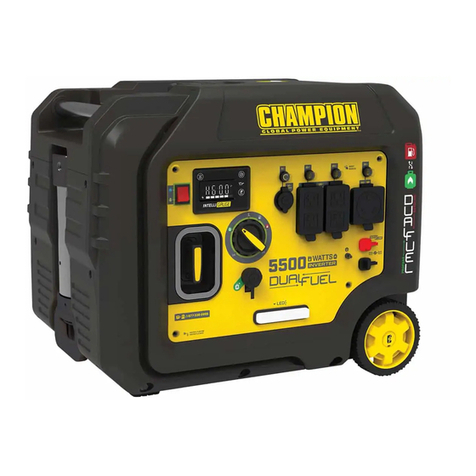
Champion Global Power Equipment
Champion Global Power Equipment 201003 Operator's manual
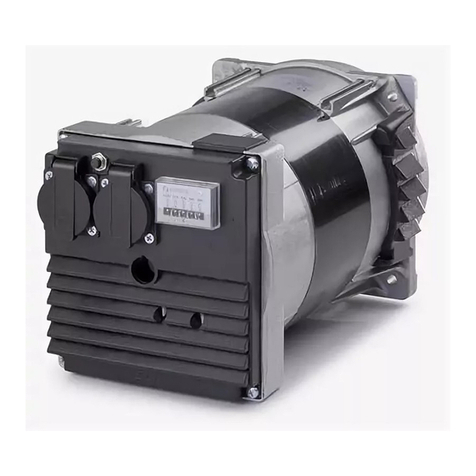
Sincro
Sincro EP Series Use and maintenance manual
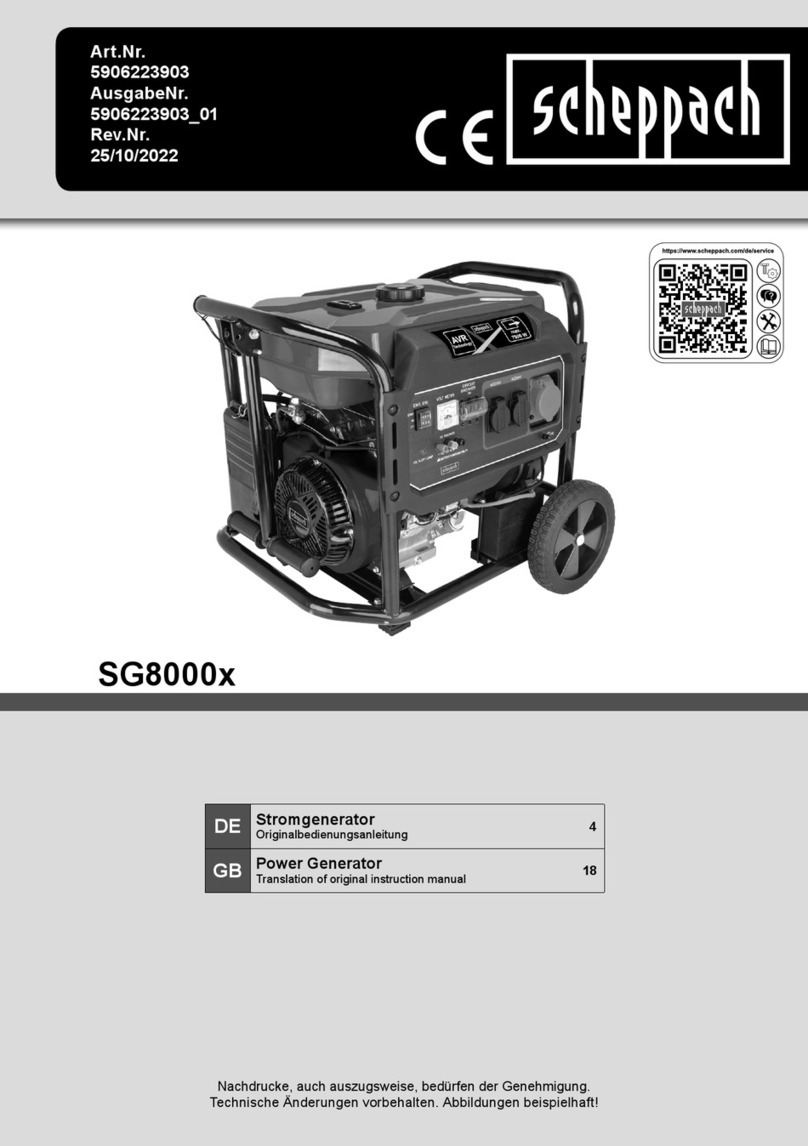
Scheppach
Scheppach SG8000x Translation of original instruction manual
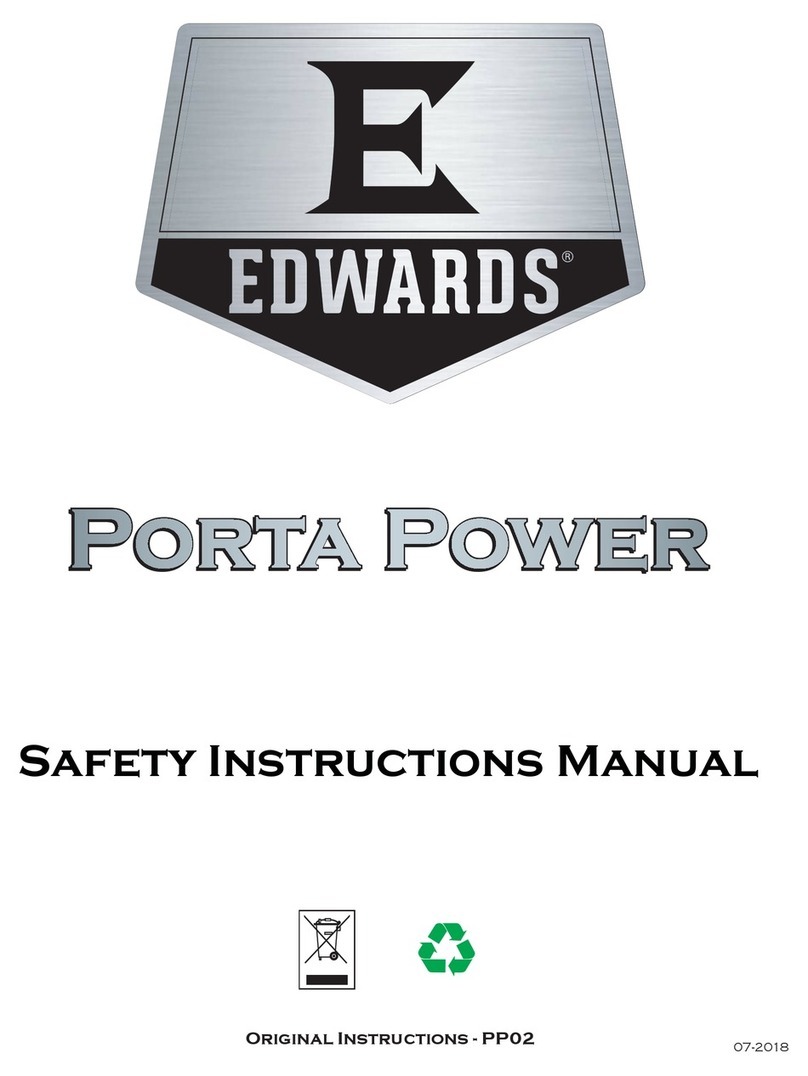
Edwards
Edwards Porta Power Safety & instruction manual

Toyama
Toyama TG3100 owner's manual
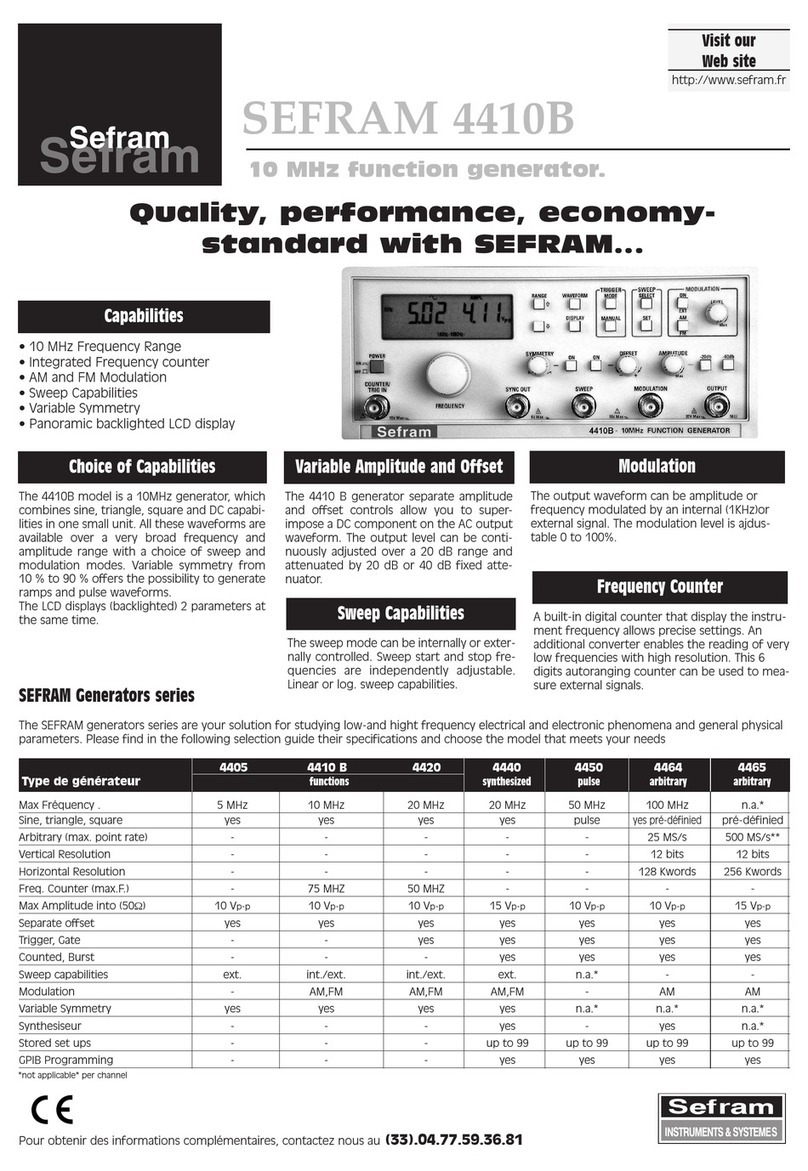
SEFRAM
SEFRAM 4410B quick start guide


